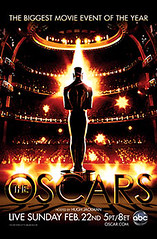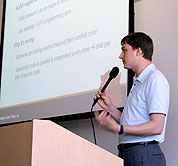Growing up, I was pretty active physically. But after leaving home for college and pursuing a career in computers, my activity level continued to fall while my weight moved in the opposite direction. I tried numerous times to start working out regularly, but I would always fall off the wagon after a matter of weeks when life got extra busy. While I’d resisted the idea for years, last fall I finally decided to start working twice a week with a personal trainer, and the results have been fantastic–I now work out regularly and reliably (both with my trainer and on my own in between), I feel stronger, healthier, and happier, and my career is none the worse for spending the extra time I didn’t think I had.
I’ve told several colleagues this story (not surprisingly, many in Silicon Valley are in the same boat–working long hours and neglecting their health even though they’re aware that it’s a problem), and it’s inspired several of them to follow suit. And apparently I’m not alone. So I thought it would be worth recounting here both why this has worked so well and why it nevertheless took me far too long to convince myself to do it.
What’s so great about a personal trainer?
The biggest advantage by far of working with a personal trainer is that I actually go work out regularly now. That’s because my trainer puts our appointments on my calendar every week, waits for me to show up, and charges me money if I don’t. That may sound glib, but the core problem I’ve had for the past few years is that I couldn’t bring myself to work out regularly on my own. I’d get too busy, or there wouldn’t be a convenient time, or I’d be tired, or whatever, but the bottom line is it wouldn’t get done, and now it does. I like to think of myself as someone with a strong will, a good sense of discipline, and a rational, long-term outlook, but clearly I’m not the only one that finds it hard to “kick my own butt” into exercising regularly. Instead of worrying about exactly what exercises to do and how often, the “high-order bit” in fixing my situation was “just show up a few times a week and do anything“.
In retrospect, the solution is so obvious: success looks like you blocking off an hour on your calendar a few times a week to go to the gym, and doing that consistently for the foreseeable future. Rather than trying to convince myself to do this ad hoc on my own, working with a trainer ensures this outcome by design. It’s a classic form of the well-known “brain hack” where you force yourself into doing something you know is right for you by creating the conditions in advance, when you’re rationally detached, rather than in the moment, when your baser instincts are in firmer control. And since I pay for my sessions in chunks of 10, and my trainer books our appointments every week, it really keeps me “on the treadmill” (both literally and figuratively).
Of course, there’s more to the value of working with a trainer than just the “forced accountability” to actually show up. My trainer knows what I’m capable of, where my weak spots are, and what my goals are (I just want to be in decent shape, not a body builder or top athlete), and she tailors our workout each time to keep me working on the right exercises with the right intensity and variety. She definitely pushes me harder than I would work on my own (“you can do one last set, can’t you? come on…”), but she also keeps me safe by watching my form and adjusting or eliminating exercises if anything is starting to hurt or look weird. This in turn lets me “turn my brain off” by not having to will myself to keep going or worry about what exercise to do next or whether I’m doing it right (all of which I’d have to do if I were working out solo), and as a result I get a more efficient and impactful workout for the time allotted.
What took you so long?
For several years, “not being in great shape”–or, more specifically, “not having regular exercise be a built-in part of my lifestyle”–has been at the top of my list of personal problems I’d like to improve. I’ve been quite fortunate in terms of family and career (my big problem being “I just want to work all the time”), but I just couldn’t seem to get “work out regularly” checked off my life’s to-do list. Reflecting on why it was so hard for me to tackle this problem–even though I cared about fixing it and had the means–I think it boiled down to the following combination of factors, which many people in my situation also face:
- It’s not a crisis (yet). I was never “dangerously over weight”, just a bit pudgier than I’d like, and with the situation slowly worsening over time. I gained on average about 5 lbs per year since getting married, though my weight often fluctuated that much in the space of a week, so it was the long-term trend that was a problem, but in the short term it was hard to convince myself “you’ve got to drop everything and deal with this now“.
- I should be able to fix this on my own. As I mentioned above, I tend to think “I’m a smart, capable person, so I don’t need help from other so-called professionals” when it comes to solving my problems. Especially for getting in shape, I know how to do it, and my needs are fairly modest and normal, so I often told myself that getting a personal trainer amounted to “being a wuss” and admitting a lack of will power or discipline or knowledge, which was “unbecoming for someone of my abilities”.
- It’s expensive. While I’m well-employed enough to reasonably afford to pay a personal trainer, it’s still a lot of money. My trainer is part of Google’s “g-fit” program, and I pay a subsidized rate of $50/hour (it’s often higher at private gyms). Meeting twice a week works out to roughly $5,000/year for this service. That’s a serious chunk of change, and although “it’s hard to put a price on your health and happiness”, it was enough to further fuel my apprehension about “taking the plunge”.
- I can’t afford the time. Probably the single biggest deterrent to getting in shape was my inability to convince myself that the few hours a week I would need to dedicate would actually be worth the opportunity cost of less time working or less time spent with my family. As a “startup guy”, both at Plaxo and more recently building Google+, I always feel like there’s more to do and it really matters and the impact is real. In other words, I have the “first-world problem” that I love my job, I’m good at it, and I have the chance to really change the world and get well compensated in the process. So it’s always hard to pull myself away from that, even to spend time with my family, whom I adore and already don’t see enough. Thus taking even more time away to work something as “vain and optional” as improving my physique was just a hard thing to convince myself was a worthy use of my limited time.
Now rationally, of course, I realize that none of these arguments actually make much sense. Of course staying healthy is important and worthwhile, of course it’s a reasonable (and ultimately modest) investment of time and money, and of course “Parkinson’s law” will ensure that my career will not go up in flames because I spend a few hours a week working out. I know of plenty of people who are a lot busier and more important than me that work out regularly and swear by it, so clearly this is a solvable problem with plenty of “existence proofs”. But it held me up for years nonetheless, so I bring it up in the hopes that if some of these excuses ring a bell for you, this might help you fight back.
Is it really worth the investment of money and time?
Obviously not everyone can afford a personal trainer, but I would argue that for most busy professionals, it’s both achievable and money well spent. Most people I know in Silicon Valley work really hard and wish they were in better shape, but are actually bounded more by time than by money to do something about it. So once you convince yourself that you can afford the time, the money should actually be “the easy part”. If someone offered to wave a magic wand and make you healthy and active for the cost of $5,000, I bet a lot of people would take it. Yet that’s exactly what you can do by getting a trainer (and even cheaper if you do small group sessions or only meet once a week). It’s particularly convenient at Google because they have on-site trainers and on-site gyms with lockers/showers (so it really is as simple as “going to my 3pm meeting on the first floor”), but many people live or work near gyms and have flexible enough schedules that they can pencil in time with a trainer a couple times a week. And of course, as many people told me before (and I’m telling you now), it does come with a “high ROI” in terms of having more energy, sleeping better, and spending less time worrying that you’re not getting in shape.
In short, I couldn’t be happier with the choice to start working with a personal trainer, and if you’re anything like me, I bet you’d feel the same if you gave it a try. Let me know if you do (or have already done so recently); I’d love to hear from more people who are figuring out how to be healthy and geeky at the same time!







